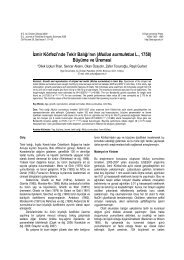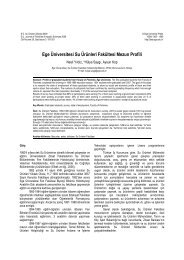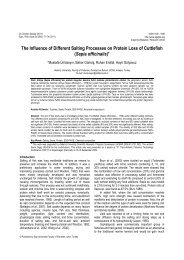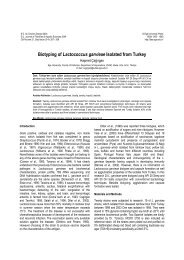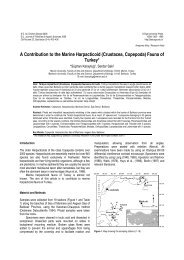Method for Monitoring Lipid Oxidation in Fish - Journal of Fisheries ...
Method for Monitoring Lipid Oxidation in Fish - Journal of Fisheries ...
Method for Monitoring Lipid Oxidation in Fish - Journal of Fisheries ...
Create successful ePaper yourself
Turn your PDF publications into a flip-book with our unique Google optimized e-Paper software.
E.Ü. Su Ürünleri Dergisi 2006<br />
E.U. <strong>Journal</strong> <strong>of</strong> <strong>Fish</strong>eries & Aquatic Sciences 2006<br />
Cilt/Volume 23, Sayı/Issue (3-4): 331–334<br />
© Ege University Press<br />
ISSN 1300 - 1590<br />
http://jfas.ege.edu.tr/<br />
Comparison <strong>of</strong> Two Thiobarbituric Acid (TBA) <strong>Method</strong> <strong>for</strong> <strong>Monitor<strong>in</strong>g</strong> <strong>Lipid</strong><br />
<strong>Oxidation</strong> <strong>in</strong> <strong>Fish</strong><br />
*Bahar Tokur 1 , Koray Korkmaz 1 , Deniz Ayas 2<br />
1Çukurova Üniversitesi, Su Ürünleri Fakültesi, Avlama ve İşleme Teknolojisi Bölümü, Adana, Türkiye<br />
2Mers<strong>in</strong> Üniversitesi, Su Ürünleri Fakültesi, Avlama ve İşleme Teknolojisi Bölümü, Mers<strong>in</strong>, Türkiye<br />
*E mail: b_tokur@yahoo.com<br />
Özet: Balıklarda lipit oksidasyonunu belirlemek iç<strong>in</strong> iki tiyobarbiturik asit (TBA) metotunun karşılaştırılması. Bu çalışmada,<br />
yağlı balıklarda önemli bir kalite kriteri olan tiyobarbiturik asit (TBA) analizi, standart bir distilasyon metodu olan Tarladgis ve diğ.<br />
(1960) ve bir sıvı asit ekstraksiyon metodu olan Lynch and Frei (1993) olmak üzere iki farklı yöntemle karşılaştırılmıştır. Tarladgis ve<br />
diğ. (1960)’ nın yöntem<strong>in</strong>de 7.8 sabiti ile çarpılan specktr<strong>of</strong>otometrik değerler, ayrıca Crackel (1986)’ <strong>in</strong> önerdiği üzere 6.2 sabiti ile<br />
de çarpılmış ve elde edilen TBA değerleri karşılaştırılmıştır. Araştırmada kullanılan küçük boylu sardalyaların (Sard<strong>in</strong>a pilchardus<br />
(W., 1972), 12.7±0.15 cm) lipit içeriği %1.59, büyük boylu sardalyaların (S. pilchardus (W., 1972),16.5±0.98 cm) lipit içeriği %2.18,<br />
küçük boylu kefaller<strong>in</strong> (Mugil cephalus (L., 1758) 21.0±0.68 cm) lipit içeriği %2.08, büyük boylu kefaller<strong>in</strong> (M. cephalus (L., 1758),<br />
33.2 ±1.23 cm) lipit içeriği %0.97, palamutun (Sarda sadra (B., 1793), 32.1±3.25 cm) lipit içeriği %6.49 ve lüfer<strong>in</strong> (Pomatomus<br />
saltator (L., 1766), 23 ± 1.01cm) lipit içeriği %1.19 olarak bulunmuştur. Küçük boylu kefallerde ve büyük boylu sardalyalarda<br />
ekstraksiyon metoduna göre elde edilen TBA değerleri, 6.2 sabiti ile hesaplanarak bulunan distilasyon metoduna ile elde edilen TBA<br />
değerler<strong>in</strong>e göre önemli bir farklılık göstermezken (p>0.05), 7.8 sabiti ile hesaplanan TBA değerleri 1.3 kat daha yüksek<br />
bulunmuştur (p
332 Tokur et al. / E.Ü. Su Ürünleri Dergisi 23 (3-4): 331–334<br />
method requires distillation units, which can place a limitation<br />
on the number <strong>of</strong> samples that can be analyzed <strong>in</strong> one day.<br />
The foam<strong>in</strong>g <strong>of</strong> distillate accord<strong>in</strong>g to some fish species dur<strong>in</strong>g<br />
distillation is also other disadvantage <strong>in</strong> distillation methods.<br />
As consequences <strong>of</strong> this, the aqueous acid extraction method<br />
is preferred by many workers because it is simple and gives<br />
results that are highly correlated with those <strong>of</strong> distillation (Pikul<br />
et al. 1989) Although many procedures have been developed<br />
to measure the aqueous acid extraction method <strong>for</strong> MDA, all<br />
variations are similar <strong>in</strong> that they each have a critical heat<strong>in</strong>g<br />
step with an acid to liberate MDA from its precursors or bound<br />
<strong>for</strong>ms as well as to separate the TBA-reactive substances<br />
(TBARS) from food matrix (Pikul et al. 1983, Peg et al. 1992).<br />
TBA reagent may be added with an acid to food directly and<br />
the mixture be added with an acid to food directly and the<br />
mixture then heated <strong>for</strong> a sufficient period <strong>of</strong> time to obta<strong>in</strong><br />
maximum color development. The p<strong>in</strong>k pigment <strong>for</strong>med dur<strong>in</strong>g<br />
heat<strong>in</strong>g may be extracted <strong>in</strong>to butanol or a butanol-pyrid<strong>in</strong>e<br />
mixture after cool<strong>in</strong>g and then quantified (Peg et al. 1992).<br />
Among the aqueous acid extraction, the methods<br />
described by Tarladgis et al. (1960) is the most extensively<br />
used to estimate rancidity <strong>of</strong> fish and fishery products. The<br />
purposed <strong>of</strong> this study was to evaluate the aqueous acid<br />
extraction accord<strong>in</strong>g to Lynch and Frei (1993) <strong>for</strong> monitor<strong>in</strong>g<br />
lipid oxidation <strong>in</strong> fish.<br />
Material and <strong>Method</strong>s<br />
Small sard<strong>in</strong>e (Sard<strong>in</strong>a pilchardus (W., 1972), 12.7±0.15 cm),<br />
large sard<strong>in</strong>e (S. pilchardus (W., 1972),16.5±0.98 cm), small<br />
grey mullet (Mugil cephalus (L. 1758), 21.0±0.68 cm), large<br />
grey mullet (M. cephalus (L. 1758), 33.2 ±1.23 cm), Atlantic<br />
bonito (Sarda sadra (B., 1793), 32.1±3.25 cm) and bluefish<br />
(Pomatomus saltator (L. 1766), 23 ± 1.01cm) compared with<br />
distillation and extraction methods were obta<strong>in</strong>ed from a local<br />
grocery fish store <strong>in</strong> Adana and immediately transferred to<br />
laboratory <strong>in</strong> iced.<br />
The lipid contents <strong>of</strong> fish samples were analyzed<br />
accord<strong>in</strong>g to Bligh and Dyer (1951) lipid extraction method.<br />
The distillation TBA method was per<strong>for</strong>med as described<br />
by Tarladgis et al. (1960). The homogenized 10 g <strong>of</strong> fish<br />
sample was transferred to a Kjeldahl flask and 97.5 ml <strong>of</strong><br />
distillated water and 2.5 ml <strong>of</strong> 6 N HCl. The mixture was<br />
heated with steam distillation until 200 ml <strong>of</strong> distillate was<br />
collected. Five ml <strong>of</strong> distillate was added to 5 ml <strong>of</strong><br />
thiobarbutiric reactive reagent conta<strong>in</strong><strong>in</strong>g 0.02 M TBA <strong>in</strong> 90 %<br />
glacial acetic acid and <strong>in</strong>cubated <strong>for</strong> boil<strong>in</strong>g water <strong>for</strong> 35 m<strong>in</strong>.<br />
After cool<strong>in</strong>g with tap water, the absorbance <strong>of</strong> the p<strong>in</strong>k<br />
solution was read at 538 nm. The constant 7.8 and 6.2 were<br />
used to calculate the distillation TBA number as<br />
recommended by Tarladgis et al. (1960) and Crackel (1986),<br />
respectively.<br />
The acid extraction TBA method was per<strong>for</strong>med as<br />
describe as Lynch and Frei (1993). Muscle samples (1 g)<br />
were homogenized <strong>in</strong> 10 ml KCl 0.15 M + BHT 0.1 mM with a<br />
Polytron (1 m<strong>in</strong>, medium speed). Samples <strong>of</strong> 0.5 ml <strong>of</strong><br />
homogenate were <strong>in</strong>cubated with 1% (w/v) 2-thiobarbituric<br />
acid <strong>in</strong> 50 mM NaOH (0.25 ml) and 2.8% (w/v) trichloroacetic<br />
acid (0.25 ml) <strong>in</strong> a boil<strong>in</strong>g water bath <strong>for</strong> 10 m<strong>in</strong>. After cool<strong>in</strong>g<br />
at room temperature <strong>for</strong> 20 m<strong>in</strong>, the p<strong>in</strong>k chromogen was<br />
extracted with n-butanol (2 ml) and its absorbance measured<br />
at 535 nm aga<strong>in</strong>st a blank <strong>of</strong> n-butanol. TBA-RS<br />
concentrations were calculated us<strong>in</strong>g 1,1,3,3<br />
tetraethoxypropane (0–0.8 µM) as standard. Results were<br />
expressed as mg MDA per kg <strong>of</strong> meat (TBA units).<br />
The effects <strong>of</strong> methods on TBARs value were analysed<br />
by one-way analysis <strong>of</strong> variance (ANOVA). The comparison <strong>of</strong><br />
the TBA numbers <strong>in</strong> different fish species calculated accord<strong>in</strong>g<br />
to Tarladgis et al. (1960), Crackel (1986) and Lynch and Frei<br />
(1993) were per<strong>for</strong>med <strong>for</strong> significance by Duncan’s multiple<br />
range tests. Three replications were made and six read<strong>in</strong>gs<br />
were made <strong>for</strong> each replication. The SPSS statistical package<br />
version 7.5 was used <strong>for</strong> statistical analysis.<br />
Results and Discussion<br />
The results <strong>of</strong> lipid contents and TBA numbers <strong>in</strong> different fish<br />
species obta<strong>in</strong>ed by distillation and extraction methods are<br />
given <strong>in</strong> Table 1.<br />
Table1. The TBARs values (mg malonaldehyde/kg meat) <strong>of</strong> different fish species obta<strong>in</strong>ed by distillation and extraction method 1,2<br />
<strong>Fish</strong> species Total <strong>Lipid</strong>s Extraction method Distillation Calculated by constant 7.8 <strong>Method</strong> Calculated by constant 6.2<br />
Grey mullet<br />
small 2.08±0.87 1.974 ±0.163 a 2.474± 0.112 b 1.967± 0.069 a<br />
large 0.97±0.04 1.119±0.171 a 0.785±0.086 b 0.624±0.030 c<br />
Sard<strong>in</strong>e<br />
small 1.59±0.04 2.177±0.586 a 2.574±0.313 a 2.046±0.249 a<br />
large 2.18±0.07 6.159±0.221 a 8.210±0.327 b 6.526±0.260 a<br />
Atlantic bonito 6.49±0.34 1.779±0.203 a 1.119±0.117 b 0.953±0.093 b<br />
Bluefish 1.19±0.06 0.397±0.116 a 0.413±0.024 a 0.329±0.019 a<br />
The lipid contents <strong>of</strong> fish used <strong>in</strong> the experiment were<br />
found to be 1.59% <strong>for</strong> small sard<strong>in</strong>e (Sard<strong>in</strong>a pilchardus,<br />
12.7±0.15 cm), 2.18% <strong>for</strong> large sard<strong>in</strong>e (S. pilchardus,<br />
16.5±0.98 cm), 2.08% <strong>for</strong> small grey mullet (Mugil cephalus,<br />
21.0±0.68 cm), 0.97% <strong>for</strong> large grey mullet (M. cephalus, 33.2<br />
±1.23 cm), 6.49% <strong>for</strong> Atlantic bonito (Sarda sarda, 32.1±3.25<br />
cm) and 1.19% <strong>for</strong> bluefish (P. saltator, 23 ± 1.01cm). In the<br />
present study, the low lipid contents <strong>in</strong> sard<strong>in</strong>es were not <strong>in</strong><br />
agreement with the common classification <strong>of</strong> sard<strong>in</strong>es as the<br />
fat species. It is known that the season, stage <strong>of</strong> sexual
Tokur et al. / E.Ü. Su Ürünleri Dergisi 23 (3-4): 331–334 333<br />
maturity and body size can affect the lipid contents <strong>of</strong> sard<strong>in</strong>es<br />
with values rang<strong>in</strong>g from 0.5 % <strong>in</strong> w<strong>in</strong>ter and 20% <strong>in</strong> summer<br />
(Hardy and Keay 1972, Christie 1987, Nunes et al. 1991,<br />
Bandarra et al. 1997). Additionally, the total lipid contents <strong>of</strong><br />
sard<strong>in</strong>es were found the higher <strong>in</strong> longer species than <strong>in</strong> the<br />
shorter ones. Similar results were obta<strong>in</strong>ed <strong>in</strong> sard<strong>in</strong>es by<br />
Caponia et al. (2004). The lipid contents <strong>of</strong> grey mullet were<br />
found to be higher <strong>in</strong> shorter species than <strong>in</strong> the longer ones.<br />
Perera and De Silva (1978) found that total lipid content with<br />
length <strong>in</strong>creased <strong>for</strong> reared young mullet (M. cephalus) but not<br />
<strong>for</strong> wild mullet. They expla<strong>in</strong>ed that the reason <strong>of</strong> these results<br />
may be due to the high calorific value <strong>of</strong> the food presented to<br />
the reared fish and the lack <strong>of</strong> activity <strong>in</strong> the conf<strong>in</strong>ed space <strong>of</strong><br />
the rear<strong>in</strong>g tanks. In this study, the low lipid content found <strong>in</strong><br />
Atlantic bonito may be attributed to its diet, which consists<br />
ma<strong>in</strong>ly <strong>of</strong> small pelagic fish species like sard<strong>in</strong>es (S.<br />
pilchardus) (Zaboukas et al. 2006). The lipid contents <strong>of</strong><br />
sard<strong>in</strong>es were also found to be poor <strong>in</strong> this study.<br />
TBA values obta<strong>in</strong>ed by extraction method <strong>in</strong> small grey<br />
mullet and large sard<strong>in</strong>e weren’t significantly different from<br />
those <strong>of</strong> the distillation method when calculated by 6.2<br />
(p>0.05), while TBA values <strong>of</strong> them obta<strong>in</strong>ed by distillation<br />
method calculated by 7.8 were found to be significantly 1.3<br />
times higher than those <strong>of</strong> extraction method (p
334 Tokur et al. / E.Ü. Su Ürünleri Dergisi 23 (3-4): 331–334<br />
skipjack. International <strong>Journal</strong> <strong>of</strong> Food Scie. And Technology, 67(4):730<br />
Nunes, M. L., M. Card<strong>in</strong>ali, R. Mendes, R. M.Campos, N. M. Bandarra, H. M.<br />
Lourenco, and M. Jerome. 1991. Effect <strong>of</strong> season and ice storage on<br />
prote<strong>in</strong>s and lipids <strong>of</strong> sard<strong>in</strong>e (Sard<strong>in</strong>a pilchardus) m<strong>in</strong>ces and surimi,<br />
pp. 63–72. In: Quality assurance <strong>in</strong> the fish <strong>in</strong>dustry. H. Huss, M.<br />
Jakobsen and J. Liston (Eds). Elsevier, Amsterdam.<br />
Pegg, R.B., F. Shahidi, and C.R. Jablonski. 1992. Interaction <strong>of</strong> sulfanilamide<br />
and 2-thiobarbutiric acid with malonaldehyde:structure <strong>of</strong> adducts and<br />
ımplications <strong>in</strong> determ<strong>in</strong>ation <strong>of</strong> oxidative state <strong>of</strong> nitrite-cured meats. J.<br />
Agric. Food Chem., 40: 1826-1832.<br />
Perera P. A. B. and S. S. De Silva. 1978. Studies on the chemical biology <strong>of</strong><br />
young grey mullet Mugil cephalus L. <strong>Journal</strong> <strong>of</strong> <strong>Fish</strong> Biology., 13: 297 –<br />
304<br />
Pikul, J., D.E. Leszczynski, and F.A. Kummerow. 1989. Evaluation <strong>of</strong> three<br />
modified tba methods <strong>for</strong> measur<strong>in</strong>g lipid oxidation <strong>in</strong> chicken meat. J.<br />
Agric. Food Chem., 37: 1309-1313.<br />
Pikul, J., D.E. Leszczynski, and F.A. Kummerow. 1983. Elim<strong>in</strong>ation <strong>of</strong> sample<br />
autoxidation by butylated hydroxytoluene additions be<strong>for</strong>e thiobabutiric<br />
acid assay <strong>for</strong> malonaldehyde <strong>in</strong> fat from chicken meat. J. Agric. Food<br />
Chem., 31: 1338-1342.<br />
Salih, A.M., D.M. Smith, J.F. Price, and E. Dawson. 1987. Modified extraction<br />
2_thiobarbutiric acid method <strong>for</strong> measur<strong>in</strong>g lipid oxidation <strong>in</strong> poultry.<br />
Poultry Science, 66: 1483-1488.<br />
Siu, G.M., and H.H Draper. 1978. A survey <strong>of</strong> the malonaldehyde content <strong>of</strong><br />
retail meats and fish. J. Food Sci., 43: 1147-1149.<br />
Tamura, H., K. Kitta, and T.Shibamoto.1991. Formation <strong>of</strong> reactive aldehydes<br />
from fatty acids <strong>in</strong> a Fe +2 /H2O2 oxidation system. J. Agric. Food Chem.,<br />
39: 439-442.<br />
Tarladgis, B.G., B.M. Watts, and M. Yonathan. 1960. Distillation method <strong>for</strong><br />
the determ<strong>in</strong>ation <strong>of</strong> malonaldehyde ın rancid foods. J. <strong>of</strong> American Oil<br />
Chemistry Society, 37(1): 44–48<br />
Vyncke, W. 1975. Evaluation <strong>of</strong> the direct thiobarbituric acid extraction<br />
method <strong>for</strong> determ<strong>in</strong><strong>in</strong>g oxidative rancidity <strong>in</strong> mackerel (Scomber<br />
scombrus L.). Fette Seifen Anstrichm. 77:239–240.<br />
Witte, V.C., G.F. Krause, and M.E. Bailey. 1970. A new extraction method <strong>for</strong><br />
determ<strong>in</strong><strong>in</strong>g 2-thiobarbituric acid values <strong>of</strong> pork and beef dur<strong>in</strong>g storage.<br />
J. Food Sci. 35:582-585.<br />
Zaboukas, N., H. Mılıou, P. Megal<strong>of</strong>onou, M. Moraıtou-Apostolopoulou, 2006.<br />
Biochemical composition <strong>of</strong> the Atlantic bonito Sadra sarda from the<br />
Aegean Sea (Eastern Mediterranean Sea) <strong>in</strong> different stages <strong>of</strong> sexual<br />
maturity. <strong>Journal</strong> <strong>of</strong> <strong>Fish</strong> Biology, 69: 347–362



